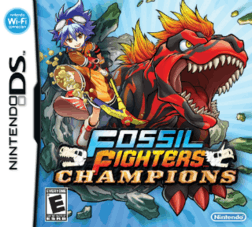Fossil Fighters: Champions
|
North American front cover of Fossil Fighters: Champions. | |
| Developer(s) |
Nintendo SPD Red Entertainment M2 Artdink |
|---|---|
| Publisher(s) | Nintendo |
| Designer(s) |
Taro Achi (scenario concept) Fukui Prefectural Dinosaur Museum (encyclopedia supervisor) |
| Series | Fossil Fighters |
| Platform(s) | Nintendo DS |
| Release date(s) | |
| Genre(s) | Role-playing video game |
| Mode(s) | Single-player, multiplayer |
Fossil Fighters: Champions, known in Japan as Super Kasekihoridā (スーパーカセキホリダー lit. "Super Fossil Diggers"), is a 2010 video game developed by Nintendo SPD, Red Entertainment, M2, and Artdink and published by Nintendo. The game is a sequel to its original title, Fossil Fighters. It was released in Japan on November 18, 2010 and in North America on November 14, 2011. It features the first 100 vivosaurs from the original game, as well as new Vivosaurs.
Gameplay
The original Fossil Fighters did a fairly well job of addicting players to the task of unearthing prehistoric creatures to do battle. It's obvious Fossil Fighters: Champions follows the first game very closely, adding a few small items but keeping the framework that proved effective. Those seeking deep combat or story mechanics will not find them here, but the addictive nature of trying to fill a complete library of prehistoric pugilists will win over quite a few. Some of them can be purchased in shops or obtained as rewards for quests, but most simply need the player to wonder around the many areas within the game where fossils are easily unearthed with a little digging in the right spot. A handy sonar is provided to showcase exactly where these spots are, and raking in the fossils is quick and easy. Once some fossils have been gathered, the job of cleaning them can begin. Using a hammer for pounding and a drill for more sensitive parts, scraping all the eons' worth of accumulated dirt off of the fossils must be done before they can be used.
The twin catches of this process are a ninety-second time limit and the inherent fragility of an exposed fossil, which can make a rush job injurious to the specimen. The time limit can be irritating, but most of the time it is not usually a major issue. The use of the DS touch screen for the cleaning is quite enjoyable, and dusting a dozen or more fossils in one sustained session becomes commonplace due to the addictiveness of the procedure. The developers were thoughtful enough to make the accumulated dirt come in many shapes and densities, ensuring that every cleaning is not the same. Champions adds a few elements to the cleaning. Now gigantic fossils that take up more than the screen can display will be found, and the cleaning of these requires manually moving the viewpoint. Consumable items can now be purchased to aid dirt removal, one of which will add thirty seconds to the timer while the other will identify any break points to instantly smash open a large chunk of the fossil.
These are very handy in dealing with certain stubborn specimens, but expensive enough to prohibit overuse until quite a while into the game. The additions don't fundamentally change the fossil-cleaning mechanics of the first game, but they do spice it up a bit for veterans. Most revived species, dubbed vivosaurs by the game, come in four separate fossils with different parts of the skeleton. Getting the head is mandatory to revive a creature, while the other parts serve to make it considerably stronger. Many vivosaurs return from the original game, but quite a few of the new species make it clear that dinosaurs are not the only prehistoric fauna group represented. Plenty of ancient mollusks will be unearthed, along with a few types of mammoth. Getting bored of the options available for combat will not be a problem.
Fossil Fighters: Champions' title makes it clear that battles will occur, and they proceed in an intuitive way that owes almost everything to the first game. Three of the player's species are pitted against three of the enemy's in a turn-based melee. Each species has unique abilities, and a four-point elemental system that determines strengths and weaknesses is in effect, but the result is not something that will require intense tactical analysis from the player. It's quick and easy to understand, while those who wish to delve into competitive play can achieve quite a bit.
The story battles are unlikely to cause much frustration to all but the most easily flummoxed. Computer opponents often have strong resources but don't use them intelligently, allowing the player to triumph without excess effort. Unlike the first game, vivosaurs can be leveled with no real limit, allowing a team of incredibly powerful behemoths to be created with a little patience. The last battles in the story mode are more challenging than those that came before, but any RPG veteran won't have problems.
Fossil Fighters: Champions expands on the features present in the original Fossil Fighters and in many cases introducing new options as well. Side Quests from the original Fossil Fighters return in the sequel, but have now been organised and a list of the available quests is provided by the Info Clerk in the Fossil Guild. The player can now choose to be either a boy or a girl at the start of the game and unlike the first you are given a choice of one of four starter vivosaurs (one for each element except Neutral). Also you can use auto to let the game battle for you and you can rotate your team. (You will be able to find that vivosaur at Treasure Lake and Hot Spring Heights).
External links
- Official website (English)
- Official website (Japanese)
